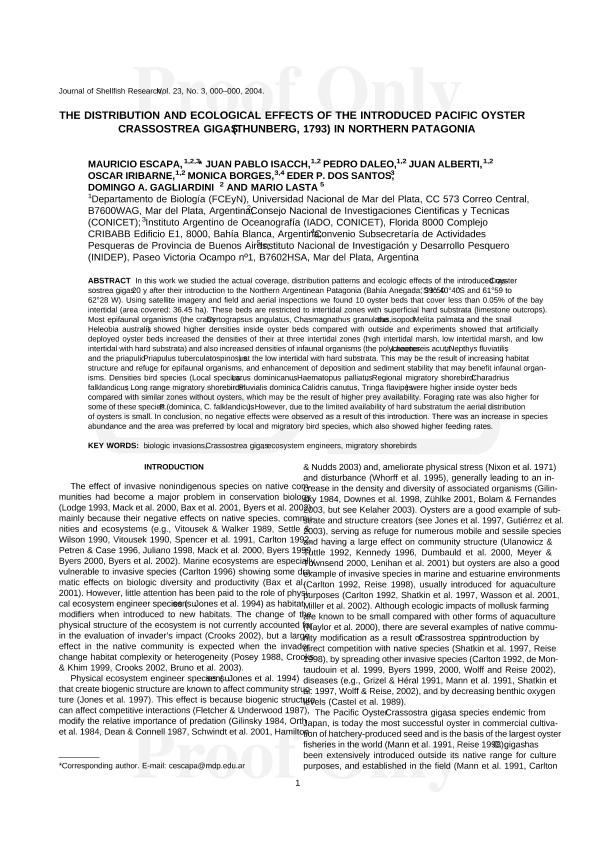Artículo
The distribution and ecological effects of the introduced Pacific oyster Crassostrea gigas (Thunberg, 1793) in Northern Patagonia
Escapa, Carlos Mauricio ; Isacch, Juan Pablo
; Isacch, Juan Pablo ; Daleo, Pedro
; Daleo, Pedro ; Alberti, Juan
; Alberti, Juan ; Iribarne, Oscar Osvaldo
; Iribarne, Oscar Osvaldo ; Borges, Mónica Elisa; Dos Santos, Eder Paulo
; Borges, Mónica Elisa; Dos Santos, Eder Paulo ; Gagliardini, Domingo Antonio
; Gagliardini, Domingo Antonio ; Lasta, Mario
; Lasta, Mario
 ; Isacch, Juan Pablo
; Isacch, Juan Pablo ; Daleo, Pedro
; Daleo, Pedro ; Alberti, Juan
; Alberti, Juan ; Iribarne, Oscar Osvaldo
; Iribarne, Oscar Osvaldo ; Borges, Mónica Elisa; Dos Santos, Eder Paulo
; Borges, Mónica Elisa; Dos Santos, Eder Paulo ; Gagliardini, Domingo Antonio
; Gagliardini, Domingo Antonio ; Lasta, Mario
; Lasta, Mario
Fecha de publicación:
12/2004
Editorial:
Natl Shellfisheries Assoc
Revista:
Journal Of Shellfish Research
ISSN:
0730-8000
Idioma:
Inglés
Tipo de recurso:
Artículo publicado
Clasificación temática:
Resumen
In this work we studied the actual coverage, distribution patterns and ecologic effects of the introduced oyster Crassostrea gigas 20 y after their introduction to the Northern Argentinean Patagonia (Bahia Anegada; 39º50´S to 40º40´S and 61º59 to 62º28 W). Using satellite imagery and field and aerial inspections we found 10 oyster beds that cover less than 0.05% of the bay intertidal (area covered: 36.45 ha). These beds are restricted to intertidal zones with superficial hard substrata (limestone outcrops). Most epifaunal organisms (the crabs Cyrtagrapsus angulatus, Chasmagnathus granulatus, the isopod Melita palmata. and the snail Heleobia australis) showed higher densities inside oyster beds compared with outside and experiments showed that artificially deployed oyster beds increased the densities of their at three intertidal zones (high intertidal marsh, low intertidal marsh. and low intertidal with hard substrata) and also increased densities of infaunal organisms (the polychaetes Laeonereis acuta, Nepthys fluviatilis, and the priapulid Priapulus tuberculatospinosus) at the low intertidal with hard substrata. This may be the result of increasing habitat structure and refuge for epifaunal organisms, and enhancement of deposition and sediment stability that may benefit infaunal organisms. Densities bird species (Local species: Larus dominicanus, Haematopus palliatits: Regional migratory shorebird: Charadrius falklandicus; Long range migratory shorebirds: Pluvialis dominica, Calidris canutus, Tringa flavipes) were higher inside oyster beds compared with similar zones without oysters, which may be the result of higher prey availability. Foraging rate was also higher for some of these species (P. dominica, C. falklandicus). However, due to the limited availability of hard substratum the distribution of oysters is small. In conclusion, no negative effects were observed as a result of this introduction. There was an increase in species abundance and the area was preferred by local and migratory bird species, which also showed higher feeding rates.
Archivos asociados
Licencia
Identificadores
Colecciones
Articulos(CCT - MAR DEL PLATA)
Articulos de CTRO.CIENTIFICO TECNOL.CONICET - MAR DEL PLATA
Articulos de CTRO.CIENTIFICO TECNOL.CONICET - MAR DEL PLATA
Articulos(IADO)
Articulos de INST.ARG.DE OCEANOGRAFIA (I)
Articulos de INST.ARG.DE OCEANOGRAFIA (I)
Citación
Escapa, Carlos Mauricio; Isacch, Juan Pablo; Daleo, Pedro; Alberti, Juan; Iribarne, Oscar Osvaldo; et al.; The distribution and ecological effects of the introduced Pacific oyster Crassostrea gigas (Thunberg, 1793) in Northern Patagonia; Natl Shellfisheries Assoc; Journal Of Shellfish Research; 23; 3; 12-2004; 765-772
Compartir



